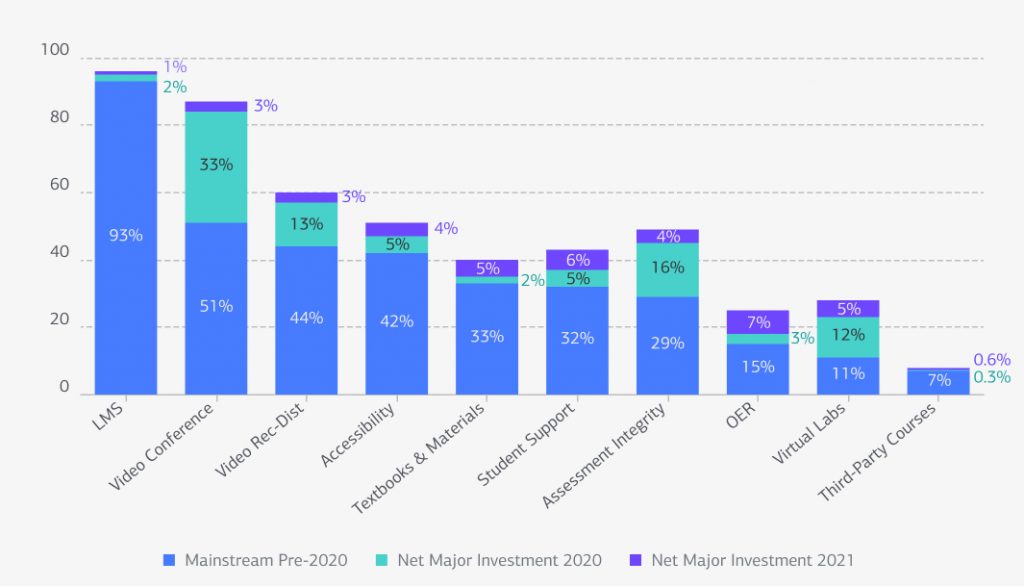Keeping up with new trends in educational technology has become essential for today’s educators. Innovative technology enables educators to improve their students’ experience and provide opportunities to meet expanding learning requirements.
We have seen new educational methods emerge since the pandemic moved learning from the classroom to the home. Solutions such as online classes keep the learning process running, and augmented reality and immersive learning trends are essential for leveraging growth and boosting the learning experience.
In this article, we’ll find out why EdTech’s popularity is constantly growing and analyze the most important trends in EdTech.
What is EdTech?
EdTech is digital technology, such as computer hardware or software, that is intended to improve or simplify the teaching and learning process by means of education software development. It includes physical items such as interactive whiteboards, computers or tablets, or translation equipment. It might also be software, such as virtual reality programs or online learning platforms. EdTech trends 2023 are intended to facilitate more straightforward teaching and learning.
Why will EdTech be popular in 2023?
The online education industry has become more diverse and extensive due to top trends in educational technology. The customer may now select the format and other features of educational services.
People in 2023 want to learn in a dynamic atmosphere and require a personalized approach. As a result, they are interested in gamification and digital technology. They would like education to be an exciting process as well. The EdTech sector is becoming more integrated into the educational structure, with various mechanics to promote engagement and interest in learning.

EdTech products support and personalize education. Students may examine and revise lessons at any time, allowing them to choose their own learning pace. Teachers also provide them with personal feedback and valuable educational materials.
Let’s take a closer look at the future trends in educational technology to stay on top of innovations in 2023.
10 EdTech Trends of 2023
Artificial intelligence (AI) and machine learning (ML)
AI is the “in thing” in the US EdTech business right now. According to recent industry research, the worldwide AI in the education market will reach $3.68 billion in 2023. So, why are these trends in EdTech industry growing in one of the world’s major EdTech markets? First and foremost, AI can automate basic educational operations such as grading. Teachers may now automate the grading of multiple-choice and fill-in-the-blank questions. Thus, automatic writing grading may not be far behind.

Furthermore, AI can benefit both students and teachers. AI tutors, for example, might assist students when teachers are too busy to care for everyone. Furthermore, AI-powered systems can provide helpful feedback to both students and teachers. As a result, some schools implement AI systems to monitor student development and inform teachers when there is a problem with a student’s performance. So why don’t you use AI to assist your students in getting more out of their educational experience?
Game-based learning
The latest EdTech trends 2023 are gaining popularity because they promote student involvement. Gamification has been employed in classrooms in many ways, such as leaderboards, award points, badges, stickers, etc. Gamification is the only trend in education technology that ensures a rise in participation, engagement, and competition.
Students get more interested in classroom activities to improve their grades and leaderboard ranks. And the motivation to lead the scoreboards leads to increased performance and retention.
Gamification motivates students to study and practice, improving the learning experience. As a result, teachers utilize gamification to promote engagement, motivate students, and create a dynamic classroom environment.

In either case, it helps to boost students’ morale and inspires them to do better every time. We can see this trend growing in more creative ways to improve the learning model.
Augmented reality (AR) and virtual reality (VR)
Augmented and virtual reality can help make the classroom more dynamic and immersive. Immersive learning is the ideal solution for students who need new experiences. Immersive learning involves all of the senses of the learners. Whereas VR creates a constructed reality, AR delivers a more accurate and augmented picture of the image.

Immersive learning delivers an enjoyable learning experience by allowing students to observe environments. This technology makes some topics more accessible to students. Participating in experiments and seeing real historical locations may take lessons to life and directly impact student performance in class.
Blockchain Technology
Blockchain is a data structure. A blockchain stores information in small units known as blocks. As these fill up, they connect to previously full blocks, establishing the blockchain data string. Blockchain technology can play a key role in the education industry, particularly in data storage.
This trend has changed student credentials and certificate record-keeping, eliminating the requirement to validate degrees and other academic documents. Blockchain ensures transparent ledgers, which helps to reduce workplace fraud.

Blockchain guarantees academic qualifications are honest and transparent. Once an institution has recorded information in its online ledgers, changing it is difficult — you will need authorization from network users to do so. This technology can prevent fraud and keep data safe. By keeping all data on a blockchain platform, which makes it almost impossible to edit without admin access, blockchain technology may help solve issues such as plagiarism. In this approach, blockchain sets the foundation for a more transparent and improved future.
Asynchronous Learning
Asynchronous online learning allows students to be more flexible and independent during the school day. It enables students to create their own study schedule within a specific timeframe. Students may access educational materials and information at any time during the week if they complete their assigned projects and responsibilities. Asynchronous learning allows students to participate actively in their education while also practicing self-sufficiency and time management skills. This is made possible via online learning, which allows students to access resources from any place.

Social Media in Learning
Who would have thought that social media would be considered part of the learning process? Every day, education technology trends change at a fast pace. With children having social media profiles on multiple platforms, keeping them away from social media for a long time is challenging. As a result, teachers discovered a way to leverage this trend and transform it into a valuable tool for improving the learning process.
Educational institutions have begun to use social media as a means of communication for students to interact with their classmates and faculty members. Students typically share movies and photographs with their friends and followers. They may, however, exchange study materials, opinions, projects, and so on via social elements embedded in their eBooks.

They may leave comments on other people’s postings or offer information to other websites, all while developing peer networks and improving the online learning experience. Teachers enable students to utilize social media as part of their learning model because it keeps students interested and boosts engagement. Social media is here to stay, and incorporating it into learning modules will foster a collaborative and sharing culture, resulting in a better learning experience.
Collaborative Learning
Innovative trends in education technology have enabled everyone to stay connected. The effect of contemporary ICT changes in education has created several opportunities. We collaborate to connect, discuss, and act on situations. This collaborative method has also gained traction in the learning process. Teachers foster cooperation in the classroom learning model by giving group activities and assignments.
Students improve their collaboration skills when they work together on a project or solve an issue. Working together promotes their comprehension and involvement.
Although eLearning is quite popular, it also incorporates collaborative aspects such as sharing and discussing. A typical teaching approach involves a teacher entering a classroom, speaking for around 30 minutes, and then leaving when the bell sounds. However, technology has now bridged the gap between students and teachers.

Teachers and students would engage with one another more often. Teachers are now much more available and act as mentors to assist students in their whole development. This collaborative learning technique encourages students to communicate with one another and develop interpersonal skills.
STEAM
STEAM is an improvement above STEM, its predecessor. This new abbreviation stands for science, technology, engineering, art, and mathematics. It is a set of skills that educators encourage students to learn. Art is a new component in this equation that encourages creativity. Arts and humanities programs teach students about personal expression, empathy, and purpose. The incorporation of arts in the curriculum has boosted creativity and encouraged students to attempt new things. Integrating arts in STEM is a movement that may attract other students to pursue a STEM career.
Interactivity in Classroom
The use of technology in the classroom has made it more dynamic and interactive. The course material can be integrated with videos, augmented reality, audio files, and other media in eBooks. Unlike traditional books, eBooks allow for more involvement in the classroom. Thanks to the flipped classroom approach, students may now accomplish all of their studying at home and all of their practical work at school.
All of these new technologies have changed the way that classes used to function in the past. Teachers may now help students with their class assignments.

They can have discussions and activities in the classroom, resulting in an interactive setting in which students are fully engaged in the learning process. Many schools and institutions have made interaction and involvement a priority. This learning technique has grown in popularity in recent years because it keeps students engaged in the classroom.
Mobility
The high prevalence of smart devices, such as computers, smartphones, and tablets, has changed how educators communicate and engage with pupils. According to one assessment, the number of such smart devices has more than doubled during the pandemic. And technologies like IoT (Internet of Things) offer connectivity, allowing education service providers to establish a connected education system and give students with online learning experiences.

Mobility will be one of the most important education technology trends in 2023. It enables students to access data in real-time and to engage in asynchronous learning, which means studying at their own pace. Furthermore, mobility facilitates nano-learning. Students may study and review instructional information in small, packaged forms, as well as learn via social media platforms and share it as needed.
Conclusion
Finally, we know that there is a considerable amount to take in when discussing educational technology trends. However, remember that technology has entered education and completely transformed the teaching and learning process. Especially eLearning, an educational tool that not only makes education more accessible and convenient but also affects students’ learning behaviors and motivations to study.
But there’s good news: you don’t have to travel alone on this EdTech ship since you have us EVNE Developers IT Service Company, to help you get the essential value of learning, inspire learners, and make education more relevant and robust.
Meanwhile, you can check the future of real estate technology with our article.


















